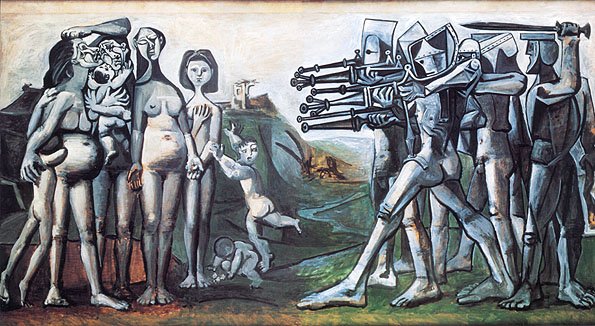How “cold” was the Cold War, really?
Using essential questions to foster nuanced discussions in the high school History classroom.
Massacre in Korea (1951) is an anti-war painting by Pablo Picasso depicting the 1950 No Gun Ri Massacre during the Korean War, a brutal Cold War proxy war. For the Korean people, the Cold War was anything but “cold.”
The Cold War is a complex and content-heavy topic. Unfortunately, from my experience as a history teacher, it often falls chronologically towards the end of my courses and therefore ends up being rushed without getting the proper attention it deserves.
We spend so much time studying the World Wars and the interwar years (also very important topics, of course!) that the next 75+ years from 1945 to the present end up being treated as an afterthought. While the Cold War offers immense potential for critical analysis and historical thinking, I felt that my students were left with a vague sense of a conflict between the Soviet Union and the United States in which war was avoided.
It was this realization, however, that led me to introduce an engaging essential question that would guide my history students through their study of the Cold War: How “cold” was the Cold War, really?
Using this question has led to much more critical engagement and has encouraged a more nuanced understanding of this historical era.
What’s in a Name? Challenging the “cold” in the Cold War
One of my favourite practices as a history teacher is encouraging students to challenge historical naming conventions (see our post on the so-called “Roaring Twenties”). It’s a simple and effective way to think about an era from multiple perspectives and realize that history is about interpretation and debate, rather than a set of facts and terms to memorize.
When it comes to the Cold War, it’s easy to see that the term “cold” - that is, lacking in direct, military conflict - did not apply to everyone involved. For example, the Korean War (1950-53) and the Vietnam War (1955-1975) were both Cold War proxy conflicts that led to the destruction of entire countries and millions of civilian deaths. For Koreans, Vietnamese, and countless other people around the world, the Cold War was… well… extremely hot.
When it comes to the Cold War, it’s easy to see that the term “cold” – that is, lacking in direct, military conflict – did not apply to everyone involved.
So, questioning the term “Cold War” is not just a matter of nomenclature. Rather, it is about gaining a better understanding of the global impacts of the conflict and how it affected the lives of people far beyond the borders of the two major superpowers. It’s about understanding the Cold War from multiple perspectives.
Timeline Activity with a Historical Thinking Twist!
In order to present students with the content necessary to answer the essential question, I have them create a “Living Timeline” using 24 major events from the Cold War era (1945-1991).
Like a traditional timeline, a living timeline includes a horizontal axis (x-axis) with the years labeled accordingly. But unlike a traditional timeline, it also includes a vertical axis (y-axis). In this case, the vertical axis represents the degree to which each specific event represented “heating up” or “cooling down” of the Cold War.
So, in order to place any event on the timeline, students need to consider not just the dates involved, but they also need to think about its impact on the countries and people involved. With this simple tweak, students are forced to think critically about the content. The level of discussion, engagement, thoughtfulness and learning increases dramatically!
Upon completion of the timeline, students are equipped with plenty of evidence and examples they can use to answer the essential question. If I’m looking for an engaging way to introduce a content-heavy topic, or I’m in a time crunch, the living timeline activity is my go-to teaching strategy!
Want to try this lesson in your own history class? Click on the link below! Our “Introduction to the Cold War” lesson includes everything you need to engage your students in the Cold War Living Timeline activity!



